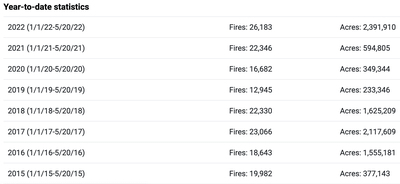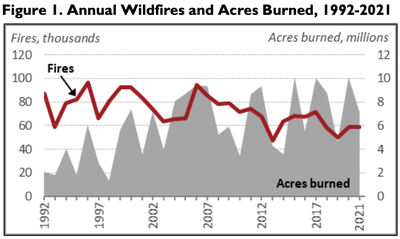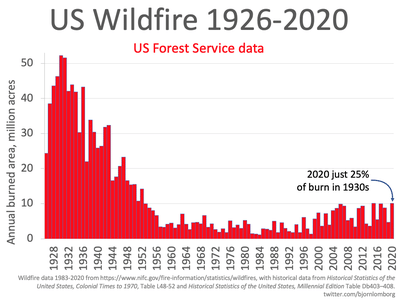Last summer's forest fires were super bad and this year simply "being better" isn't a good metric. 5%-10% less burn acreage is "better," but it's not significant, especially as it pertains to air and water quality. The PNW looks to be pretty good, but that's it. The SW is already experiencing above normal fires and this is projected to continue. It has been an abnormally dry and windy year, leading to more than two million acres burning across several states this year already. This is 70% higher than the ten-year average. Just look at this picture comparing Jan thru May fire stats for the whole US over the last eight years.

As of yesterday, there are six new large fires, including in Florida and Mississippi. Even humid states are getting affected by droughts. New Mexico has the largest fire in its history already and it's not even summer yet. The short winter and occasional bought of strong precipitation have lead to a lot of plant growth that later dies and dries, providing a lot of fuel. Additionally, the fuel that exists seems to be getting more arid, leading to hotter fires. Despite what it feels like lately, there is a nation-wide drought that is probably not going away anytime soon.

Finally, even if the total fire acreage is less than last year, there is increased risk to humans. There has been a disproportionate amount of population growth in areas most prone to wildfires and their effects. More people are moving to mountains and forests, cities are expanding into the wildlands, and tourism continuous to grow. This places more people and structures in the path of fires and their smoke. Despite increased red-flag warnings and fire awareness, more people camping, hiking, and driving increases the chances of human-started fires. Just see the Superior fire in Colorado last winter, it was started on a red-flag day. Finally, fire itself and smoke aren't the only dangers caused by wild fires. They increase the likelihood of flooding and landslides, increasing the impact on environment and people alike. This is made worse by all the fast and heavy storms that seem to be taking place this year. Flash flooding in general is expected to increase this year. I expect areas impacted by fires from the last several years and this year to be even more prone to flash floods.
TLDR: This will be a scary year for the US and I only expect it to get worse over the next decade. Go check out these sources for a lot more insightful information and some great graphics.
https://www.predictiveservices.nifc.gov/outlooks/monthly_seasonal_outlook.pdf
https://www.nifc.gov/fire-information/nfn
https://www.climate.gov/news-features/understanding-climate/us-spring-outlook-2022-drought-expand-amid-warmer-conditions
https://fennerschool.anu.edu.au/research/research-stories/fastest-population-growth-american-west%E2%80%99s-wildland-urban-interface-areas
https://www.nature.com/articles/s43247-021-00299-0
https://www.for.gov.bc.ca/hfd/pubs/docs/bro/Bro91.pdf
https://sgp.fas.org/crs/misc/IF10244.pdf
https://www.sciencedaily.com/releases/2022/04/220401141335.htm
https://www.washingtonpost.com/weather/2021/07/20/dry-thunderstorms-wildfire-west/
**This thread was edited on May 20th 2022 at 4:40:09pm
















